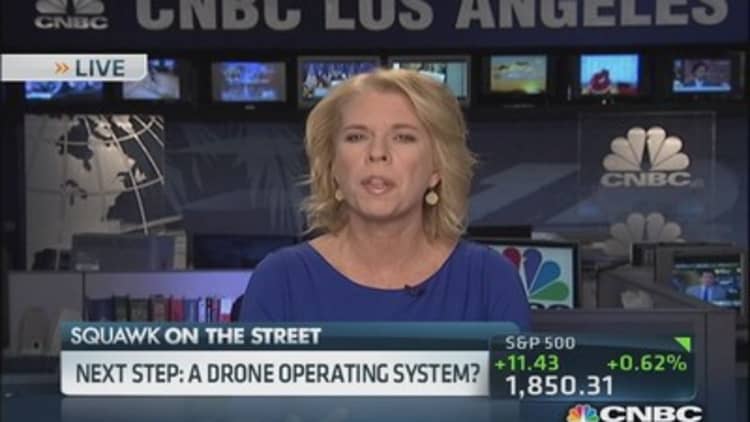
The Pentagon's long spending spree on unmanned aerial systems, or drones, has started to end as budgets tighten.
But less money can be smart money.
The Defense Department has been pushing for off-the-shelf software than can be used across multiple drone platforms. It may be hard to believe, but after all the billions spent on unmanned aircraft, each product line has its own operating system, and they are not compatible. Having a common system would improve interoperability, boost efficiency and drive down costs.
It could also make drones more vulnerable to hacking, which is why it has taken so long for anyone to come up with a solution.
(Read more: Startups, investors bet on drone economy)
A Los Angeles-based start-up, DreamHammer, has created Ballista, which it hopes will become the Windows or Android of unmanned devices in space, air, land and sea.
"There are going to be billions of devices, real hardware systems, tied to this global network," said DreamHammer's CEO and co-founder, Nelson Paez. Creating a common system for drones took the company four years.
"No one has solved that problem," he said. "They didn't solve it in defense, and they've been trying for about 20 years or so."
DreamHammer's software layers onto a product and can be used to do everything from monitoring surroundings, to controlling and moving unmanned aircraft. The program allows apps to be created and added by third parties. It also allows for upgrades to be transmitted, and, for the first time, lets a customer get inside the software and customize it.
"If you wanted to have a satellite look for something, find what it needs to, and then go send a drone to have a high-resolution image on it, the system can 'tip and cue' by itself using our software," Paez said. "Those two worlds don't talk together right now."
Partners such as General Atomics tell CNBC that Ballista has tested well in the lab; field tests are next. The company is offering the product as a bonus in potential deals with foreign governments and companies, where buyers often want to change software.
Poland, for example, is considering buying a "family of UAVs" from General Atomics, AeroVironment and L-3, and Ballista could be used in all those products.
Lockheed Martin tells CNBC that it also has been testing Ballista in high-end simulations, with field tests planned later this year. Lockheed wants to integrate the software into some of its unmanned systems to give the military "added capabilities."
Both General Atomics and Lockheed said that while they are open to similar operating systems, they know of no business other than DreamHammer that has created an off-the-shelf, easy-to-use product. Ballista is also relatively cheap, at about $50,000 per system.
(Read more:Dealing in drones: The big business of unmanned flight)
Security is a major concern, of course, as an open system is more vulnerable to hacking. General Atomics will be using DreamHammer only to monitor its UAVs; the software won't be able to take control of the aircraft.
Lockheed said it has heavily encrypted software to prevent hacking once users get past Ballista's upper layer.
Paez said DreamHammer works on security constantly.
"The public confidence is everything in this business," he said, adding that the company faced an uphill battle persuading defense contractors to be open to sharing some sort of command and control with other drones.
"It took a number of years," Paez said. "This has not been an easy process."
Ballista is also being used for smaller commercial companies, including Ocean Aero. It is producing a "Submaran": an unmanned device that can float on the surface of the ocean and also drive 200 meters under the water to monitor pipelines, currents, temperature or whatever a customer might want.
"DreamHammer allows us to have an across-the-board control of all our platforms," said Ocean Aero President and CEO Eric Patten, who hopes to have a fully autonomous version of the craft by this fall.
"Being ... able to modify [the software] allows us to keep up with technology," he said. "Having a ubiquitous system that allows you to operate multiple vehicles and multiple types of vehicles gives you great capability across the planet."
DreamHammer originally was in business and defense IT, doing well enough to fund its first $2 million.
After the company showed off a prototype of Ballista in 2011, the Navy got interested, as did some "high-net-worth individuals," and DreamHammer has brought in another $6.5 million, Paez said.
Ballista went on the market in August, and sales have already reached $3.5 million.
The next large market is in the commercial sector.
The Senate held hearings Wednesday about the potential economic benefit of having unmanned aircraft in U.S. airspace, and the Federal Aviation Administration has chosen six test sites for domestic drones.
General Atomics expects commercial use in the U.S. by 2018, but other countries, including Australia, already allow commercial UAVs in their airspace. Australian company Cybertech is now a DreamHammer customer.
However, given the slow pace of commercial drone approval in the U.S., is DreamHammer too early to market?
"That was a fear of ours initially," Paez said, "and that's the reason we had a big government market for this first. There's no question that we can make the money that we're making for our shareholders during this time. But for this type of pioneering technology—nobody knows exactly when it's going to hit."
And when it does hit, will DreamHammer end up the platform of choice? Paez hopes so.
"We've been at this for four years. It takes time to figure this stuff out."
—By CNBC's Jane Wells; Follow her on Twitter: @janewells


